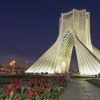
Tajrish and the Bazaar
Surrounding Tajrish, one of the oldest neighbourhoods in Shemiran in the north of Tehran, a fusion of traditional and modern Iranian lifestyle has created quite a unique vicinity, wherein, however high-rises and tall towers are, unfortunately, peaking in numbers, one is still likely to breathe in the freshness of the old gardens and aged tall trees while walking through quite narrow pathways remained from the past.
Originally, Tajrish, apart from being a traditional neighbourhood where, by and large, more advantaged people lived, used to be the hub of road and transport network which connected Tehran to many villages and the countryside towards north and northeast. It still serves the function, though almost all of those villages are, now, inside the greater Tehran. And since it is quite near the mountains and replete with cafes and restaurants it is also a sort of leisure centre for Tehraners, specifically at hot summer nights when the remainder of the old greenery still provides the passers-by with a cool breeze or two.
Tajrish Bazaar
Tajrish Bazaar, a quite significant feature and one of the attractions of the area, is located on the south side of Tajrish square and right beside the mausoleum of Imamzade Saleh. A recently renovated traditional bazaar with a lot of, almost, perpendicular packed corridors and busy arms crossing at compact and crowded halls which continue from Tajrish to Qods square. Since it is situated in the vicinity of the mausoleum many shops deal in religious goods, the likes of beads, praying Chador and Matt and also salt, candles and birds’ food for offerings in the sacred place. However, main part of the bazaar has been dedicated to providing the locals with their basic needs and since it is extremely popular all over Tehran, a lot of citizens from other neighbourhoods opt for shopping as well as an excursion with family in Tajrish and the baazar.
Passing through the main entrance of Tajrish bazaar, one would arrive at a colourful packed hall loaded with diverse types of fruit, vegetables and people; a tableau-vivant of colours, odours, tastes and postures. During Ashoura mourning period this hall, which is also called “Tekye Tajrish”, has traditionally been home to ceremonies, a wooden cradle, which is one of the emblems of these ceremonies, hangs upon the roof of this hall. However, when the mourning period is over, no matter what is on offer, shops are very much tastefully decorated with all sorts of colourful goods; as if these goods are merely meant to lure the customers. Various kinds of pickles, fragrant spices and aromatic herbs, Saffron of supreme quality, diverse range of fine tobacco, neatly wrapped bundles of fresh vegetables, different berries and other dried fruit, Fresh olive of numerous types and etc. Nevertheless, shopping in the bazaar is not restricted to the edible; one can purchase all sorts of pots and pans, beauty and cosmetic products, fabrics and clothes, carpets, handicrafts, books and stationary, building and plumbing tools and material, even if one is not in the mood for shopping they can still enjoy the very much lively atmosphere. Façades of shops and roof in the corridors has recently been renovated in an utterly traditional style using the original bricks and quite remarkable azure tiling. Perpendicular to these corridors, narrow arms take masses of people to the street between the two squares, both sides of these arms are packed with old and new shops, one after another trying to turn onlookers to customers.
Traditional food to taste in Tajrish
After spending time in the noisy and crowded bazaar, hanging out with family or friends in one of the cafes and restaurants around Tajrish, specifically for having the utterly popular traditional Ice cream, Kebab and Dizi, is very much recommended.






